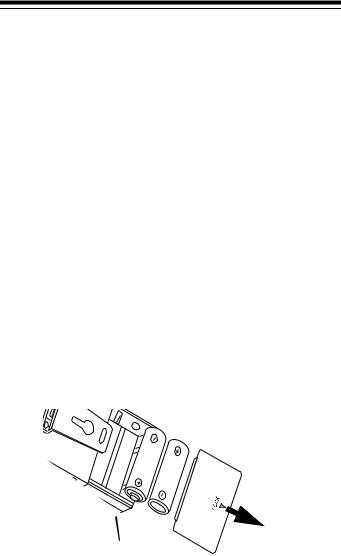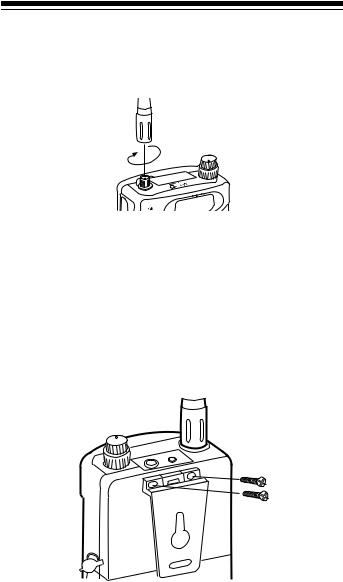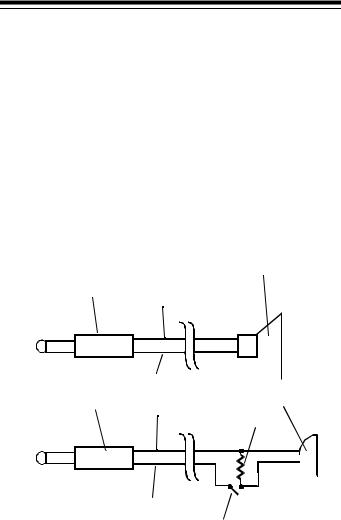Radio Shack HTX-200 User Manual

Cat. No. 19-1102
OWNER’S MANUAL
Please read before using this equipment.
HTX-200
Mini Handheld Two-Meter FM
Amateur Transceiver

FEATURES
Your RadioShack HTX-200 Mini Handheld Two-Meter FM Amateur Transceiver is compact and lightweight, making it easy to carry almost anywhere. The crystal controlled circuitry provides accurate and stable frequency selection, making it an ideal choice for your amateur communications needs.
Note: You must have a Technician Class or higher Amateur Radio Operator’s License, and a call sign issued by the FCC, to legally transmit using this transceiver. Transmitting without a license carries heavy penalties. Getting a license is easier than ever. See “Introduction to Amateur Radio” on Page 7 for more information.
Here are some of your transceiver’s features.
Up To 2 Watt Output — the transceiver transmits at 200 mW output when powered by internal alkaline batteries, or at 2 Watt output when powered by an external 9-volt power source.
CTCSS (Continuous Tone Coded Squelch System) Subaudible Tone — both encodes and decodes 47 subaudible tones to help reduce interference from other nearby systems operating on the same frequency.
Repeater Offset — lets you select the appropriate offset value to match a local repeater.
Scan — the transceiver scans the frequency range and the memory locations for transmissions.
Power Save — conserves battery power when the transceiver is not transmitting or receiving.
Programmable Frequency Steps — let you set the frequency increment for tuning or scanning to 5, 10, 12.5, 15, 20, 25, 50 kHz, or 1 MHz steps.
©1999 Tandy Corporation.
All Rights Reserved.
RadioShack and Adaptaplug are registered trademarks used by Tandy Corporation.
2

Paging Tones— you can set the radio to play a short, selectable paging tone when it transmits, and sound the same tone when it receives a signal.
Signal Strength Indicator — a graduated bar shows the relative strength of the received signal.
Time-Out Timer — lets you set a maximum transmission time interval from 0 to 161/2 minutes in 10-second increments.
Busy Channel Lock Out — prevents transmitting while the selected channel is receiving a signal.
TX Delay — reduces squelch tail when communicating using CTCSS.
Scan Delay — delays the restart of scanning when the radio locks onto a channel.
Earphone Jack and External Microphone Jack — let you connect an optional earphone, external microphone, or combination headset, for more flexible operation.
External Power Jack — lets you use an external power source for maximum output.
30 Memory Locations — let you store up to 30 frequencies and other settings.
Back Light — makes your transceiver easy to operate in lowlight situations.
Key Lock — lets you lock the transceiver’s keys to prevent accidentally changing settings.
We recommend you record your transceiver’s serial number here. The number is on the transceiver’s back panel.
Serial Number ____________________________
3

MANUAL CONVENTIONS
Your transceiver’s buttons perform multiple functions. The abbreviation or symbol for a function is printed on, below, or above each button.
To activate certain transceiver features, you must press FUNC (function) and another button at the same time. Those key combination instructions are printed as the first button name, +, then the second button name. For example, FUNC+LOCK means hold down FUNC while you press LOCK.
Button names are printed in small, bold, capital letters such as BEEP or SC. Words, symbols, and numbers that appear on the display are printed using a distinctive typeface, such as
146.940 or BUSY.
FCC INFORMATION
This device complies with Part 15 of the FCC Rules. Operation is subject to the following two conditions: (1) This device may not cause harmful interference, and (2) this device must accept any interference received, including interference that may cause undesired operation.
4

CONTENTS |
|
Introduction to Amateur Radio ............................................. |
7 |
Preparation ............................................................................. |
9 |
Power Sources .................................................................. |
9 |
Using Internal Batteries ............................................. |
9 |
Testing Internal Batteries ......................................... |
10 |
Using AC Power .............................................................. |
11 |
Using Ni-Cd or Ni-MH Battery Power .............................. |
11 |
Using Vehicle Battery Power ........................................... |
12 |
Connecting the Antenna ................................................. |
13 |
Attaching the Belt Clip .................................................... |
13 |
Attaching the Wrist Strap ................................................ |
14 |
Connecting a Microphone/Speaker ................................. |
14 |
Using the Menus .................................................................. |
16 |
Using the HTX-200’s Menus ........................................... |
16 |
A Quick Look at the Controls .............................................. |
19 |
A Quick Look at the Display ................................................ |
22 |
Operation .............................................................................. |
23 |
Turning on the HTX-200 .................................................. |
23 |
Selecting Frequencies (Direct Tuning) ............................ |
23 |
Receiving Transmissions ................................................. |
24 |
Temporarily Opening Squelch ......................................... |
24 |
Transmitting ..................................................................... |
25 |
Understanding Repeaters ................................................... |
26 |
Setting the Repeater Offset Frequency .......................... |
27 |
Turning Duplex Operation On and Off ............................. |
27 |
Setting the Repeater Offset Direction ............................. |
28 |
Reversing the Transmit and Receive Frequencies .......... |
28 |
Memory Operation ............................................................... |
29 |
Storing a Transmit/Receive Frequency ........................... |
29 |
Recalling Memories ........................................................ |
30 |
Clearing A Single Memory .............................................. |
30 |
Using the Calling-Frequency Memory ............................. |
31 |
5

Scanning Operation ............................................................. |
32 |
Scanning for Active Frequencies ..................................... |
32 |
Using Scan Delay ..................................................... |
32 |
Scanning Standard Memory Locations ........................... |
32 |
Setting A Memory Location to Always Skip |
|
During Scanning ...................................................... |
33 |
Temporarily Locking Out (Skipping) Locations |
|
During Memory Scanning ........................................ |
34 |
Continuous Tone Coded Squelch System Features ......... |
35 |
Tone Paging ..................................................................... |
37 |
Sending Paging Tones ..................................................... |
37 |
Other Special features ......................................................... |
38 |
Changing the Transmit Frequency Range ....................... |
38 |
Locking the Keypad ......................................................... |
38 |
Lighting the Display ......................................................... |
38 |
Turning the Key Tone On and Off .................................... |
39 |
Checking the Current Memory Settings .......................... |
39 |
Setting the Frequency Step ............................................. |
39 |
Power Save ..................................................................... |
40 |
Time-Out Timer ............................................................... |
40 |
Reducing Squelch Tail ..................................................... |
41 |
Busy Channel Lockout .................................................... |
41 |
Troubleshooting .................................................................... |
42 |
Care and Maintenance ......................................................... |
43 |
Using the Keypad Diagnostic .......................................... |
44 |
Resetting the HTX-200 .................................................... |
44 |
Specifications ....................................................................... |
45 |
6

INTRODUCTION TO AMATEUR RADIO
Your transceiver is the perfect first radio for anyone entering the exciting world of amateur radio, as well as a great additional transceiver for the experienced amateur radio operator. Your transceiver opens a door for you to the world from almost anywhere! All you need is an Amateur Radio Operator’s License (Technician Class or higher) issued by the Federal Communications Commission (FCC). If you do not have a license, it is easier than ever to get one, and help from licensed operators is available. Here are a few tips to help you get started.
You can turn on your transceiver and scan the entire band to hear what is going on; however, do not attempt to transmit until you get your license. If you transmit without a license, you are in violation of federal law that can lead to severe penalties. Note that ham operators take the FCC rules very seriously and want nothing to do with “bootleggers” — their term for people who operate without a license.
Find out if there is a ham radio club in your area. Most clubs welcome newcomers and are glad to help you get your license. There are thousands of clubs across the country, so there is probably one in or near your community. The staff at your local RadioShack store often can help you locate a club.
If you do not hear anyone talking about a local club as you listen to local transmissions, write to the American Radio Relay League (ARRL) at the following address to find out how to contact a local affiliate. The ARRL is the national organization representing amateur radio in the United States. The league has more than 150,000 members. Most are ham operators, or members in the process of obtaining their license.
The American Radio Relay League
225 Main Street
Newington, CT 06111
http://www.arrl.org
7

Start studying for the license exams. Do not be intimidated by the word “study,” because most people can go from knowing absolutely nothing about amateur radio to passing the Novice and Technician written exams in less than a month.
The exams test your knowledge of basic radio regulations and elementary radio theory. Many clubs hold license classes which can be a fun and easy way to learn about amateur radio. There are good books, cassette tapes, computer programs, and many other study aids available. Your local RadioShack store sells FCC License Preparation study guides for amateur radio operator licenses. While you are no longer required to learn Morse code for a Technician Class license, we encourage you to learn it anyway so you can advance to higher levels of operating privileges.
There is no fee to take the Novice exam. As soon as you pass the Novice exam, you can immediately take the Technician exam. There is a small fee required for taking the Technician exam. All license level tests are administered by a three-member Volunteer Examiner Team. Contact the ARRL for a schedule of exam opportunities in your area.
The Technician Class license lets you use the HTX-200 to communicate directly with other operators, and use repeaters for distant communication.
Amateur radio is a great hobby that has enriched the lives of millions of people all over the world. The ARRL would be glad to hear from you if you need more information or would like to join!
8

PREPARATION
POWER SOURCES
You can operate your transceiver from any of three power sources:
•internal batteries
•AC power (using an optional power supply and DC adapter)
•vehicle battery power (using an optional DC adapter)
Using Internal Batteries
Your transceiver can use two AA batteries (not supplied) for power. For the best performance and longest life, we recommend RadioShack alkaline batteries.
Cautions:
•Use only fresh batteries of the required size and recommended type.
•Do not mix old and new batteries, different types of batteries (standard, alkaline, or rechargeable), or rechargeable batteries of different capacities.
Follow these steps to install batteries.
LOCK Tab (on bottom)
1.Move the LOCK tab in the opposite direction of the arrow marked on the bottom of the transceiver.
9

2.Press down and slide the battery compartment cover in the direction of the arrow marked on the cover.
3.Put the batteries into the compartment and on top of the attached ribbon, according to the polarity symbols (+ and –) marked inside the compartment.
4.Replace the cover and slide the LOCK tab to secure the cover.
Testing Internal Batteries
When you turn on the HTX-200, BAT appears briefly and the graduated bar (the signal strentgth meter) next to BAT indicates the battery strength. If the batteries are weak, the graduated bar shows less than 4 boxes. The battery symbol (




 ) constantly indicates the battery strength. When only one or two bars appear inside the battery strength indicator, replace both batteries as soon as possible.
) constantly indicates the battery strength. When only one or two bars appear inside the battery strength indicator, replace both batteries as soon as possible.
Warning: Dispose of old batteries promptly and properly. Do not burn or bury them.
Caution: If you do not plan to use the transceiver with batteries for a two week period, remove the batteries. Batteries can leak chemicals that can destroy electronic parts.
10

USING AC POWER
You can operate the HTX-200 from AC power using a regulated power supply capable of supplying 13.8 VDC at least 1A and a vehicle power adapter (see “Using Vehicle Battery Power” on Page 12). The supply should also have an accessory power socket into which the DC-to-DC power adapter fits. If your power supply does not have an accessory power socket, you can either wire the power cord directly to your power supply or add an accessory power socket to the supply. Suitable connectors, power supplies, power cords, and sockets are available at your local RadioShack store.
The following illustration shows how to connect a typical power supply, a DC-to-DC power adapter, and the HTX-200.
USING NI-CD OR NI-MH BATTERY POWER
You can use either Ni-Cd or Ni-MH batteries to power your HTX200; however, you cannot recharge these batteries while they are inside the HTX-200. You can use a separate external charger for recharging the batteries outside the radio. Your local RadioShack store carries a selection of suitable batteries and chargers.
Note: As these batteries provide less voltage than that typically |
|
supplied by alkaline batteries, expect less transmitting output |
|
power when you use the HTX-200 with Ni-Cd or Ni-MH battery |
|
power. |
11 |

USING VEHICLE BATTERY POWER
You can power the HTX-200 from a vehicle’s 12V power source (such as cigarette-lighter socket) using an 9-volt, 900 mA DC-to- DC power adapter and a size I Adaptaplug® (neither supplied) with TIP set to +. Both are available at your local RadioShack store.
Cautions:
You must use a power source that supplies 9V DC
!and delivers at least 900 mA. Its center tip must be set to positive and its plug must fit the HTX-
200's DC 9V jack. Using an adapter that does not meet these specifications could damage the HTX-200 or the adapter.
•Always connect the DC adapter to the HTX-200 before you connect it to the power source. When you finish, disconnect the adapter from the power source before you disconnect it from the HTX-200.
Follow these steps to operate the HTX-200 from a vehicle’s battery power.
1.Insert the Adaptaplug into the HTX-200’s DC 9V jack.
2.Plug the other end of the adapter into the cigarette-lighter socket in the vehicle.
12

CONNECTING THE ANTENNA
Place the threaded base socket of the supplied antenna over the antenna connector on top of the transceiver and turn the antenna clockwise to tighten it. Turn it clockwise to remove it.
Caution: Do not over-tighten the antenna
Note: You can connect an external antenna to the HTX-200 using an SMA-to-BNC adapter. This adapter, as well as suitable antennas, are available through your local RadioShack store.
ATTACHING THE BELT CLIP
Use a Phillips screwdriver and the two supplied screws to attach the supplied belt clip to your transceiver. Do not overtighten the screws.
13

ATTACHING THE WRIST STRAP
To attach the supplied wrist strap to the top of the belt clip, thread the strap’s small loop through the opening in the top of the clip. Then insert the longer loop through the smaller loop and pull on the strap until the loop is tight.
CONNECTING A MICROPHONE/ SPEAKER
You can connect an external communications headset (consisting of a microphone and speaker) to the transceiver so you can use it privately. Lift the hinged, rubber dust cover from the MIC and SPK jacks on the top of the transceiver, then insert the plug of an optional voice activated headset with microphone, or an optional communication headset, into the jacks.
14

Caution: Use only microphone and speaker accessories that do not share a common ground for the speaker and the microphone. Doing otherwise might damage the transceiver.
Note: Inserting a headset’s plug automatically disconnects the internal speaker.
You can also connect an optional mono earphone to the SPK jack. This lets you use the transceiver’s push-to-talk button to transmit as usual. Your local RadioShack store carries a wide selection of suitable communications headsets, earphones, and separate components.
The following schematic diagram shows the typical wiring for a suitable external mic and speaker.
External Speaker
Speaker Plug
Barrel
–
+ 
Tip
MIC Plug |
External Microphone |
|
Barrel |
|
22kΩ |
–
+ 
Tip
PTT
15
